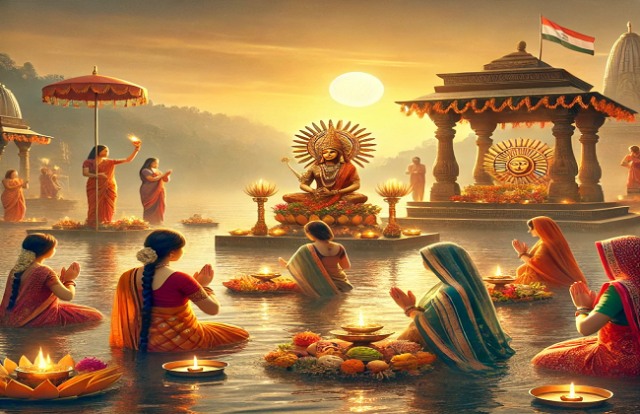History, Tradition, And Significance Of Chhath Puja: Understanding The Sacred Festival
- Posted on 07-11-2024
- News
- By Saumy Verma
- 462 Views
Chhath Puja is one of the major festivals in India, celebrated in worship of the Sun God and Chhathi Maiya. The history of this festival is linked to the Mahabharata era, and it is observed with deep devotion, particularly in Bihar, Jharkhand, eastern Uttar Pradesh, and Nepal. This four-day festival involves rigorous fasting, holy bathing, and the tradition of offering "Arghya" (water offering) to the Sun. Chhath Puja teaches us the importance of respect and gratitude towards nature, as well as unity within society.

Chhath Puja: History, Traditions, and Significance
Chhath Puja is an ancient and sacred festival celebrated with great enthusiasm in the Indian states of Bihar, Jharkhand, Uttar Pradesh, and neighboring Nepal. This festival is dedicated to worshipping the Sun God and Chhathi Maiya, primarily observed to wish for the well-being and prosperity of the family, as well as for the blessings of children. Let's dive into the history of Chhath Puja, its significance, and some key traditions associated with it.
History of Chhath Puja
The origins of Chhath Puja are believed to date back to the time of the Mahabharata. It is said that Karna, the son of the Sun God, used to perform regular worship of the Sun. He is credited with initiating the tradition of offering "Arghya" (offering water) to the Sun God. Additionally, it is believed that after Lord Rama and Sita returned to Ayodhya, Sita observed this ritual to seek the blessings of the Sun God and Chhathi Maiya.
The festival of worshipping the Sun is also believed to balance the life force, energy, and stability in human life. In Hinduism, the Sun is regarded as the primary source of life, which is why, during Chhath Puja, offerings are made to express gratitude to the Sun God.
Why is Chhath Puja Celebrated?
The main objective of Chhath Puja is to worship the Sun God to seek health, strength, and family well-being. The Sun is considered a powerful source of energy and life. During this festival, women observe a strict fast and offer "Arghya" to the Sun. Chhathi Maiya, a goddess believed to bless with offspring and protect the family, is also worshipped.
Rituals of Chhath Puja: Four Days of Tradition
Chhath Puja is a four-day festival, with each day holding special significance:
- Nahay-Khay (Day 1): On the first day, devotees take a holy bath and consume pure and sattvic (simple and vegetarian) food.
- Lohanda and Kharna (Day 2): On the second day, a salt-free meal, usually rice pudding (kheer) and bread (roti), is prepared and consumed by the devotees.
- Sandhya Arghya (Day 3): On the third day, devotees gather by a water body to offer Arghya to the setting Sun.
- Usha Arghya (Day 4): On the fourth day, devotees conclude the puja by offering Arghya to the rising Sun at dawn.
Significance of Chhath Puja
Chhath Puja is significant not only from a religious perspective but also culturally. This festival teaches us to respect and express gratitude towards nature. The elements used in the puja—like water, fruits, and clay lamps—reflect an environmentally conscious approach.
The festival also promotes unity and harmony within society. Families and communities come together to perform the rituals, fostering a sacred atmosphere that strengthens bonds and brings people closer.
In Conclusion...
Chhath Puja is a beautiful expression of discipline, sacrifice, and devotion. Celebrating it with reverence brings positive energy, joy, and prosperity into our lives. If you observe this festival, celebrate it with renewed enthusiasm this year, and cherish the heritage of our traditional festivals!




